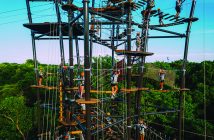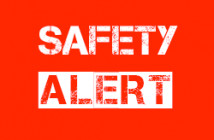When evaluating risk management and how to control risk, we often focus our efforts on participants. However, as an operator, builder or vendor in the aerial adventure industry, the greatest asset that we should focus on is our staff. Without these awesome and stellar team members, our operations would not be able to function at the level they do or, more importantly, provide the ultimate customer experience that we seek to deliver.
EMPLOYEE INJURIES:
TRENDS AND SOLUTIONS
Prior to deciding how we can reduce the amount of employee injuries, it is important to first understand trends in employee injuries. Where are they coming from? What are some common characteristics?
TREND 1: Twisting of body parts (knees, ankles, backs, etc.). This is by far the most common type of injury to employees that we see in the aerial adventure industry. Team members in the aerial industry are constantly twisting and turning on uneven surfaces.
SOLUTION: Control the claim. Unfortunately, these claims are hard to prevent or predict. They happen in the weirdest situations and times. Therefore, it is more important to control the injury after it occurs, making sure it is handled quickly and returning the employee to suitable work as soon as possible. We’ll discuss these action items in more detail shortly.
TREND 2: Falls from height. This type of incident is one of the most common for aerial adventure employees, and results in the most severe injuries. Whether it’s from six feet or 40 feet, a fall from height can be life changing or, in the worst cases, fatal. Notable trends within this trend are: 1) they involve someone who has past safety or procedure violations, and/or 2) they involve tenured staff.
SOLUTION: Create redundancy and take minor violations seriously. With most serious incidents (including falls from height), there are many “bread crumbs” of minor safety or procedure violations that lead up to it. Take these minor violations seriously, and establish a protocol for addressing them. What happens on the first violation? What about the second? Make sure the consequences are the same for all staff, including management. Remember, safety starts with the CEO/president!
TREND 3: The CEO, president, or management team fail to follow safe practices. Safety starts at the top of the organization. If the CEO of the company is not exhibiting the safety or risk management practices that the management team is preaching, the staff will lose respect for both the management and the safety practices.
SOLUTION:: The CEO, president, and/or management team should all be accountable to someone for their safety and risk management actions. Accountability is key here. The management team is not only a part of holding others accountable, but must be held accountable as well.
TREND 4: Employees don’t report injuries in a timely fashion. I would imagine that most of your employees are “rub some dirt on it and walk it off”-type people. In a way, this is great. It means they’re tough and are also hard workers. However, it’s not so great when it comes to a serious injury, because it can cost you. Statistics show that claims for injuries reported to the insurance company three or more days after the incident occurs will cost about 200 percent more than if reported earlier.
SOLUTION: Require all employee injuries be reported by sunset that day. Make it an operational procedure for staff to report all injuries, no matter how minor, by sunset on the day it occurs. Include the query on staff’s trip report, daily report, or whatever end-of-day procedure you have. It’s a question that must be asked. Make it a positive thing in your culture for staff to report injuries the day they occur, and a negative thing, with potential consequences, when an injury is reported more than a day after it occurs.
TREND 5: Employers do not have a plan of action for an employee injury. Employees, and even the managers, often do not know what the plan of action is when a team member gets hurt. Many employers fear that if staff knew about workers’ compensation or the procedures for workers’ compensation it could lead to more claims. This is a common misconception. In actuality, any misunderstanding about what to do when an employee injury happens can drastically increase the long-term cost of the claim and the operation’s workers’ compensation premiums.
SOLUTION: Cover the proper action steps during the employee hiring process. Workers’ compensation and employee injuries should be discussed during your hiring process. For example, what are the expectations if you are injured at work? What are the expectations if you see someone else injured at work? Establish the procedures and expectations from the very beginning so there is no confusion if and when something happens.
Other Practical Tips
• Create a “light duty program” for team members who are not able to return to their full capacity, but can do some light work on the ground, in the office, etc. Your insurance agent/broker can provide guidance for how to set this up.
• Designate a preferred medical provider for staff injuries, one who is familiar with your company and its objective to get injured employees into a “light duty program” as quickly as possible, in lieu of employees missing work entirely due to an injury.
The first step to reducing employee injuries and the costs associated with them is to prevent them. In my opinion, the industry as whole does a relatively good job of this. Where we can improve is the management or control of the injury after it occurs.
Instead of being reactive to the situation, be proactive. Have a set procedure or plan (even published at your operation) of what to do after an employee injury occurs. This should include all the steps, starting from going to the medical provider of your choice the day the injury occurs, all the way through to the employee returning to the position he or she held before being injured.
Your team members are your greatest asset. Protect them like your business depends on it. Because it does.






